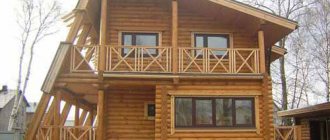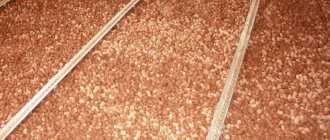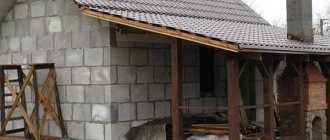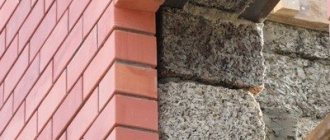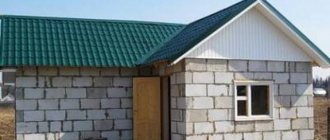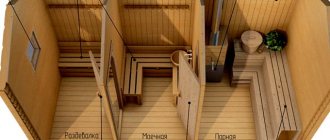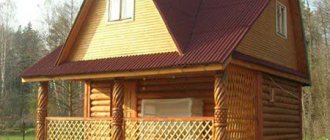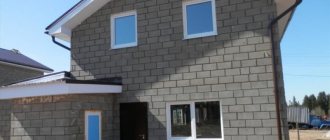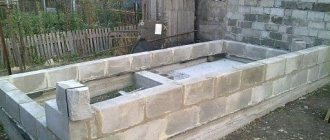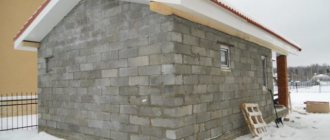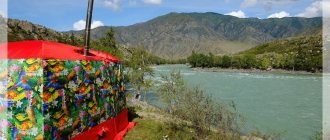What are bathhouses made of? For these purposes, wood, brick, foam blocks, expanded clay concrete are used. The main thing is that the building meets the requirements and is fireproof, environmentally friendly, retains heat and has the ability to withstand precipitation. These requirements today are perfectly met by expanded clay blocks - a type of concrete blocks filled with expanded clay. Today they are popular and in demand among builders and customers, especially private owners, due to their distinctive characteristics. And this is a kind of “economy option”.
Video of expanded clay concrete bath
As in many Russian regions, the construction of bathhouses in Samara is a consistently popular service among summer residents and homeowners in the private sector. However, wood, traditional for such buildings, becomes a rather expensive material, especially for a summer residence in the average niche, where the principle of “cheap and cheerful” prevails. By offering bathhouse projects made of expanded clay concrete blocks to residents of the region, we provide the opportunity to minimize the costs of building this almost cult object on your suburban site.
Advantages of aerated concrete and foam concrete baths
- Non-flammable - aerated concrete and foam concrete do not ignite, which is very important in a bathhouse!
- Warm - walls made of aerated concrete and foam concrete are 3-5 times warmer than brick;
- Eco-friendly - autoclaved concrete is made from natural materials without the use of chemical additives;
- Not afraid of water - aerated concrete and foam concrete consist of water-insoluble material;
- Durable - artificial stone does not burn and does not rot; it has high frost resistance F100;
- Technological - gas block and foam block are easy to process and have good geometric characteristics;
- Durable - houses up to 5 floors can be built from aerated block and foam block.
We value your time and create the most comfortable conditions for you; we have developed a special service package for the construction of a bathhouse:
- Consultation and material calculation Our specialists will advise you on the construction of a bathhouse for free, introduce you to the services, and also calculate an estimate for the construction of a bathhouse for FREE.
- Individual design Especially for you, we provide the opportunity to design a bathhouse for your convenience, taking into account modern trends and requirements.
- Our own equipment We have a fleet of our own construction equipment, which allows us to save up to 40% on their excavation work.
- Departure of a technical specialist to the site Our specialists will come to your construction site to discuss the technical part of construction on the day of your call!
We carry out the construction of a bathhouse from the following blocks: Insi-Block , AEROC, XELLA, UDK, LSR, EUROAEROBETON, YTONG, STONELIGHT, SIBIT.
Ready-made expanded clay concrete baths - the advantages of our offer
A country bathhouse relieves fatigue well and actively supports the health and vigor of lovers of real healing steam. If you choose expanded clay concrete blocks as the material, then even a custom-made structure will cost you little. At the same time, the low cost is combined with indicators of water and frost resistance, specific strength and warmth of the walls, exceeding similar parameters for buildings made of cinder blocks.
Your bathhouse made of expanded clay concrete blocks will not require special masonry mortars and additional vapor barrier of the walls; its construction provides such advantages as:
- Fast installation. Due to the large dimensions of the blocks and the absence of technological interruptions during the construction process;
- The light weight of the blocks makes it possible to save on the foundation;
- Low, no more than 15% coefficient of moisture absorption of walls (for cinder blocks this figure reaches 75%), which is especially important for periodically heated rooms;
- Convenience of plastering blocks or facing in another way;
- The service life of the building reaches 60 years or more;
- Environmental friendliness;
- Fire safety.
Construction of a bathhouse from expanded clay concrete blocks with your own hands
After the design of the expanded clay concrete bath has been drawn up, you can proceed to construction. It will not be difficult to build a bathhouse with your own hands from expanded clay concrete blocks; you can carry out the work yourself without turning to professionals.
Work on the construction of a bathhouse includes several stages.
Stage 1. Site preparation
It is necessary to clear the area of debris, trees, stones, and remove grass. If there are holes or small elevations in the area, then you need to level the area.
Stage 2. Construction of the foundation
Expanded clay concrete is a lightweight material, so there is no need to install an expensive and complex foundation. A strip or columnar foundation is suitable for a bathhouse. A column foundation will cost less than a strip foundation, but a strip foundation is more reliable. For a columnar foundation, solid expanded clay concrete blocks can be used.
If you are planning to make a simple bathhouse from medium-sized expanded clay blocks, consisting of a dressing room, steam room, washing room and rest room, then you can limit yourself to a columnar foundation. If you plan to erect a two-story building or build a swimming pool, then it is better to make a more reliable strip foundation.
Stage 3. Laying walls
Before laying the first row, you need to do waterproofing. To do this, it is necessary to apply a layer of molten bitumen to the base, and lay two layers of roofing material on top. If you need to level the floor, you can make a screed.
Hollow blocks are suitable for building walls. The first block must be placed in the corner and leveled using a level. To do this you need to use a rubber hammer; a regular one can destroy it. Then place the blocks in the remaining corners in the same way. Next, make sure that all the blocks are as level as possible. Stretch cords between them to mark future walls. Lay out the first row of blocks.
The following rows are laid out in the same way, it is important to ensure that each of them is even. It is recommended to pull the cord between the corners when laying out each row. The width of the seams between the blocks depends on the plasticity of the solution: the better it is, the thinner the seam.
Every 3-4 rows of masonry you need to make reinforcement to strengthen the walls. To do this, you can use rods with a diameter (8 mm or more) or a mesh.
To make the structure stable and reliable, it is recommended to reinforce the first row, the lower seams of window openings, as well as the supporting surfaces of door and window lintels.
It is recommended to use solid blocks for laying the last row of blocks.
After the external walls are ready, you can proceed to the construction of internal partitions, which will be connected to the load-bearing walls using anchor bolts.
When laying out the last row, you need to make “pockets” for the ceiling beams. To install the beams, metal corners should be used, and the gaps should be filled with mineral wool.
Stage 4. Roof installation
The roof for a bathhouse is usually made of one or two slopes. A more preferable option is a gable one. The roofing material can be anything: tiles, roofing felt, corrugated sheet, etc.
Using anchor bolts, you need to install the mauerlat on the walls, assemble the rafters and secure it. Sheathe the rafter structure with boards, make steam and heat insulation.
Next, you should install the roofing material.
Equipment
A turnkey bathhouse comes with the following options as standard:
- Arrangement of a strip reinforced foundation with a drain for drainage and ventilation holes;
- Construction of walls “in half a block” using the “jointing masonry” method, with their further insulation with foil-clad basalt slabs;
- Finishing with linden or coniferous “lining”;
- Arrangement of a gable roof with gables, covered with metal tiles or painted corrugated sheets;
- Installation of frame internal partitions, an insulated false ceiling made of edged boards, an insulated metal entrance door and an internal linden door, plastic windows, a 2-tier canopy made of linden slats and treating them with antiseptics, a stove with a hot water tank, a chimney;
- Painting of external wooden parts with special compounds.
Not everyone can build a bathhouse on their own, but with our help, a turnkey bathhouse becomes a reality for most private household owners.
Disadvantages of blocks
No known material can be called perfect. You need to pay attention to:
- Flowability - over the years, the outer part of the walls will crumble. This factor largely depends on the area for the construction of the building.
- Due to porosity, this type of expanded clay is significantly inferior to a concrete monolith.
- Professional calculation required.
It’s possible to build it yourself, however, before doing so you need to spend a lot of time on drawings and planning. The easiest option is to contact specialists. They will significantly reduce construction time and prevent dangerous deviations, which can reduce the life of the structure.
Photo of the interior decoration of the bathhouse
Advantages of expanded clay concrete blocks
Expanded clay concrete is a separate type of construction material. Comparing this material with all the others, we can say the following: expanded clay concrete does not absorb moisture, as foam concrete does; it is much lighter than brick; such material does not rot like wood.
Pros of blocks:
- Low thermal conductivity. Thus, there is no need to heavily insulate the building.
- Environmentally friendly material.
- It is lightweight compared to other materials.
- Hydrophobicity. This eliminates the need for a vapor barrier.
- Durability.
- Has a large selection of bricks.
- Ease of finishing and processing.
All of the above advantages have made expanded clay concrete blocks one of the best building materials for a bathhouse, which you can build with your own hands.
Furnace masonry options
When placing an order and further designing objects, we take into account any wishes of clients, however, ready-made projects, all stages of construction of which have already been worked out in practice, will help reduce the cost of construction as much as possible. On the company's website you can choose the sample you like. This could be a block bathhouse with a veranda, attic, additional wood paneling, etc. The page indicates how much each option costs, so you can easily buy a bathhouse in accordance with your own budget, focusing on the declared price.
In case of financial difficulties, we will recommend a bank that offers favorable loan conditions up to 5 million rubles for a period of up to seven years at a reasonable interest rate.
Block Features
While studying the market, you can come across a large selection of materials for construction. Finished projects will differ from each other in size and internal structure. Before making a final decision, you should study the nuances that distinguish expanded clay blocks:
- Sections do not shrink after construction like wood.
- The raw materials are environmentally friendly.
- It is much more stable than brick.
- The consumption of basic and additional material is less.
Although the price will be higher than the foam block, the result will be fully justified. There is one more feature for such buildings: a plan for them must be drawn up already when the owner knows where he will purchase expanded clay. This is due more to the peculiarities of shapes and deviations during production.
Advantages and disadvantages
Before you start building a bathhouse using expanded clay concrete, you should familiarize yourself with the main advantages and disadvantages of the structure. The advantages include:
- environmental friendliness and safety of the material;
- high level of thermal insulation;
- light weight of the blocks, which greatly facilitates the installation of the structure;
- possibility of using standard fastening solutions;
- evenness of the walls being erected;
- saving money;
- simplicity of interior and exterior decoration.
Despite many positive aspects, a bathhouse made of expanded clay concrete has disadvantages. The disadvantages include:
The porosity of a building material affects its strength, significantly reducing it.
- It is impossible to erect a structure higher than 2-3 floors, since the blocks are characterized by increased porosity and instability to mechanical stress.
- The need for external and internal cladding, otherwise the walls will begin to crack.
